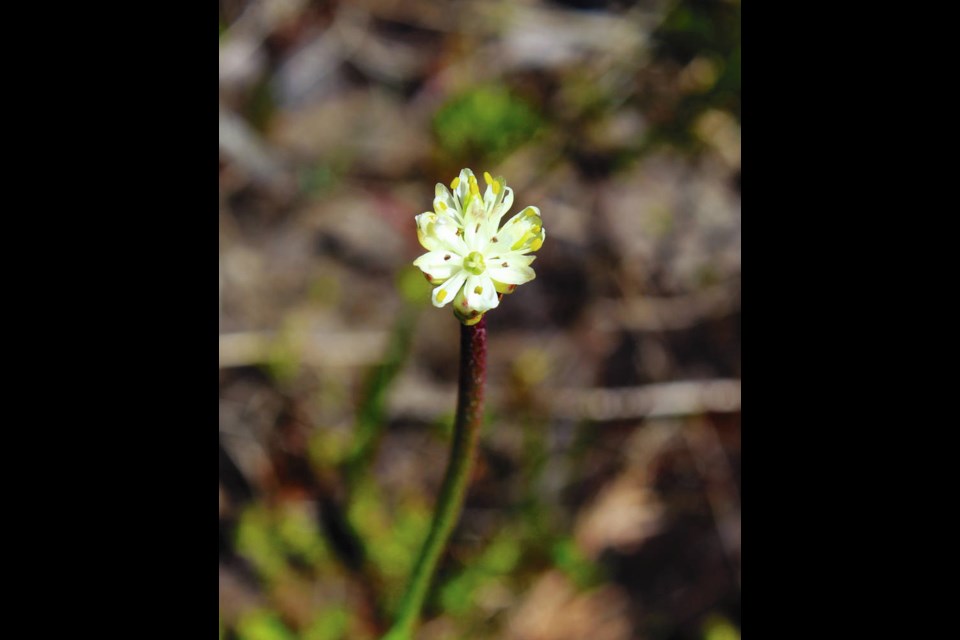It won’t bite.
But if you’re a tiny insect like a midge or gnat, and walking up the sticky stalk of a Triantha occidentalas — a flowering wetland plant commonly found on Vancouver Island and all along the Pacific coast — it will literally suck the life out of you.
The plant isn’t new. Botanists have known of its existence for about 150 years.
But now scientists at the University of British Columbia have discovered the Triantha occidentalas has evolved into a new lineage of carnivorous plant, capable of ingesting the nitrogen and phosphorus of captured prey in order to survive and thrive in an otherwise “nutrient-poor habitat.”
It’s a significant discovery because, since the time of Charles Darwin, it’s only the 12th known carnivory evolution in the plant kingdom and the first time the trait has been discovered in the Alismatales order, which contains about 4,500 species of tropical or aquatic flowering plants.
The findings, by UBC botany doctoral student Quianshi Lin and Prof. Sean Graham, along with Tom Givnish at the University of Wisconsin-Madison, were published this month in the National Academy of Sciences. It was the first new carnivorous plant discovered by scientists in 20 years.
“Carnivorous plants have fascinated people since the Victorian era because they turn the usual order of things on its head — this is a plant eating animals,” said Graham.
He said although the study area was on North Vancouver’s Cypress Mountain, “you can drive an hour out of Victoria, or Nanaimo, and find them.”
It lives in wetlands in open areas from sea level to the alpine.
What makes the Triathna occidentalas unique among carnivorous plants is its capture area isn’t in the flower, but along the stem, where a series of small sticky hairs trap small insects.
“This seems like a conflict between carnivory and pollination because you don’t want to kill the insects that are helping you reproduce,” said Lin.
Researchers found the plant was able to balance its taste for bugs with pollination because the small trapping hairs on its stem aren’t strong enough to hold major pollinators such as bees and butterflies.
“The smallest insects like midges, tiny flies and small beetles are held, but we have never found a bee or butterfly,” said Graham.
“It’s a case where this plant can have its cake and eat it, too.”
Lin built on previous work by Graham, who found Trianthna lacked a particular gene often missing in carnivorous plants.
Lin attached fruit flies labelled with nitrogen isotopes to its flowering stem. This provided a tracking system to trace nitrogen uptake by the plant. Other plants nearby, such as the carnivorous sundew and non-carnivorous species, were used as controls in the study.
Analysis found a “significant uptake of nitrogen” by Triantha, showing it received more than half its nitrogen from prey.
The study also found the sticky hairs on the stock produced a digestive enzyme used by several carnivorous plants to absorb phosphates from prey.
“In science, there is always speculating and new hypotheses. Many are tested, but many turn out to be not true,’ said Graham. “It is rare. So that is why this is a very significant discovery.”
The proximity of Triantha to major urban centres in western Canada and the Pacific coast in the United States suggests that other carnivorous plants — and many other ecological surprises — remain to be discovered, even in well-studied ecosystems.
Graham cautioned that if you want to bring Triantha home to deal with pesky summer fruit flies, please don’t. It’s not wise to uproot wild plants, and it doesn’t do well outside of its natural environment.
He suggests admiring its quirks and buggy appetite from a distance.
dkloster@timescolonist.com



